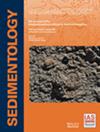东亚始新世季风气候扩张:华中江汉盆地轨道周期驱动的陆地演替证据
IF 2.6
2区 地球科学
Q1 GEOLOGY
引用次数: 0
摘要
东亚在始新世经历了复杂的气候变化。由于缺乏涵盖始新世的高精度时间框架,这一时期的沉积和气候演变特征尚不明确。江汉盆地(中国中部)发育了始新世大陆演替,由下部红层和上部盐湖沉积组成,表现出明显的沉积节律,是天文周期分析的理想对象。根据已确定的浮动天文时间尺度,盆地中的下部红层形成于始新世早中期,以偏心周期为主。上部盐湖沉积层形成于中晚新世,以偏心周期为主。地貌的变化表明,气候从持续干旱过渡到不太干旱并伴有周期性相对湿润,这是受轨道周期的影响。盐韵律岩记录的重要纬度信号响应了始新世全球温度变化和西藏地区隆升,这可能是季风气候的重要标志。对比东亚其他始新世湖盆的沉积和气候特征,始新世东亚季风的延伸可能始于约43.6-40.0Ma。这项研究为了解东亚季风的早期演变提供了一个新的视角。本文章由计算机程序翻译,如有差异,请以英文原文为准。
Eocene monsoon climate expansion in East Asia: Evidence from orbital‐cycle driven terrestrial successions in the Jianghan Basin, Central China
East Asia experienced complex climatic changes during the Eocene. Due to the lack of a high‐precision time framework covering the Eocene, the characteristics of sedimentary and climate evolution in this period remain unclear. The Jianghan Basin (Central China) developed an Eocene continental succession, which is composed of lower red beds and upper salt‐lake deposits exhibiting clear sedimentary rhythms, making these strata an ideal target for astronomical cycle analysis. Based on the established floating astronomical timescale, the lower red beds in the basin formed during the early–middle Eocene and were dominated by eccentricity cycles. The upper salt‐lake deposits formed during the middle–late Eocene and recorded obliquity cycles. The change in facies indicates that the climate transitioned from continuously arid to less arid with periodic relative wetness, which was forced by orbital cycles. Significant obliquity signals recorded by salt rhythmites responded to Eocene global temperature changes and Tibetan region uplift, which can be important markers of a monsoon‐like climate. Comparing the sedimentary and climatic characteristics of other Eocene lake basins in East Asia, the extension of the Eocene East Asian monsoon may have initiated during ca 43.6 to 40.0 Ma. This study provides a new perspective for understanding the early evolution of the East Asian monsoon.
求助全文
通过发布文献求助,成功后即可免费获取论文全文。
去求助
来源期刊

Sedimentology
地学-地质学
CiteScore
8.20
自引率
11.40%
发文量
94
审稿时长
6-12 weeks
期刊介绍:
The international leader in its field, Sedimentology publishes ground-breaking research from across the spectrum of sedimentology, sedimentary geology and sedimentary geochemistry.
Areas covered include: experimental and theoretical grain transport; sediment fluxes; modern and ancient sedimentary environments; sequence stratigraphy sediment-organism interaction; palaeosoils; diagenesis; stable isotope geochemistry; environmental sedimentology
 求助内容:
求助内容: 应助结果提醒方式:
应助结果提醒方式:


